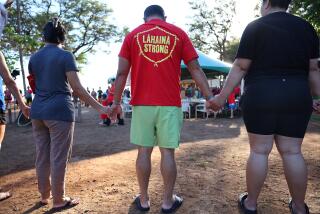Navy Returns ‘Sacred’ Island to Hawaii
- Share via
HONOLULU — One by one, about a dozen stones from Kahoolawe Island were handed over to be placed upon a sacred, hand-built Hawaiian rock altar on the grounds of Iolani Palace here.
The placement of the stones with those from other Hawaiian islands -- symbolizing the notion that Kahoolawe is returning to Hawaii -- began an emotional and historic day Wednesday as the Navy ceremonially gave the island back to the state.
Les Kuloloio, a native elder who took part in some of the first protests to get the military out of Kahoolawe in the 1970s, wiped tears from his eyes as he handed over stones for placement on the altar, known as an ahu.
“Hawaii is for native Hawaiians,” said Kuloloio. “It’s very simple, there’s no confusion about it -- native Hawaiians have a birthright here.”
The Navy took control of Kahoolawe after the Japanese attack on Pearl Harbor on Dec. 7, 1941. The 45-square-mile island, southwest of Maui, was used as a target and training area until 1990, when the elder President Bush ordered a halt after years of protests and lawsuits by Hawaiians. Congress later agreed to clean up the land and return it to local control.
Kahoolawe is sacred to native Hawaiians, who feel the island connects them to their ancestors. The island will be set aside for cultural, education and archeological activities, with no commercial development.
Navy commanders presented Gov. Linda Lingle and Lt. Gov. James R. “Duke” Aiona Jr. with U.S. and Hawaiian flags that recently flew at the Navy’s base camp on Kahoolawe.
“It’s a very emotional day,” Lingle told a crowd of about 300.
Some cultural groups carried signs decrying the continued military presence in the state, and some Hawaiian elders heckled Navy officials. Environmental and cultural groups have long fought the military over Kahoolawe and other training sites, including Makua Valley on Oahu.
On Kahoolawe, despite a 10-year, $460-million cleanup effort that is to be completed in March, about one-fourth of the island has not been cleared of ordnance and other military remnants.
More to Read
Sign up for Essential California
The most important California stories and recommendations in your inbox every morning.
You may occasionally receive promotional content from the Los Angeles Times.













